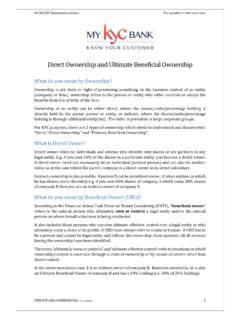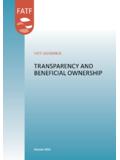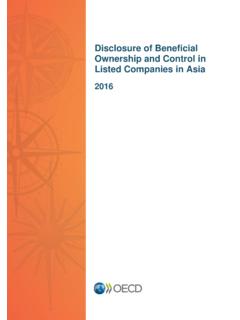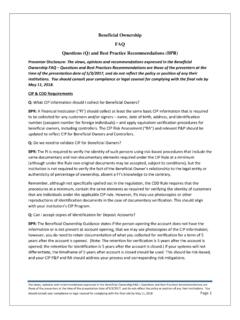Transcription of Concealment of Beneficial Ownership - Post Plen Rev
1 Concealment OF Beneficial Ownership 5 2018 | FATF Egmont Group Report EXECUTIVE SUMMARY 1. Criminals employ a range of techniques and mechanisms to obscure their Ownership and control of illicitly obtained assets. Identifying the true Beneficial owner(s) or individual(s) exercising control represents a significant challenge for prosecutors, law enforcement agencies, and intelligence practitioners across the globe. Schemes designed to obscure Beneficial Ownership often employ a hide-in-plain sight strategy, leveraging global trade and commerce infrastructures to appear legitimate.
2 However, visibility does not equate to transparency, and many of the tools that were designed to encourage business growth and development, such as limited liability corporations and nominee directorship services, can be used to facilitate money laundering, tax evasion, and corruption. The globalisation of trade and communications has only increased this threat, and countries now face the challenge of enforcing national laws in a borderless commercial environment. 2. This joint FATF Egmont Group report takes a global view assessing how legal persons, legal arrangements and professional intermediaries can help criminals conceal wealth and illicit assets.
3 The purpose of the report is to help national authorities including FIUs, financial institutions and other professional service providers in understanding the nature of the risks that they face. 3. Analysis of 106 case studies demonstrates that legal persons, principally shell companies, are a key feature in schemes designed to disguise Beneficial Ownership , while front companies and bearer shares are less frequently exploited. 4. Individuals and groups seeking to conceal the Ownership of assets are most likely to exercise control over those assets via a combination of direct and indirect control, rather than strictly one or the other.
4 In a majority of cases, the Beneficial owner used a combination of layering and direct Ownership chains, as well as professional intermediaries and third parties exercising control on their behalf. In a limited number of cases, the Beneficial owner exercised only indirect control and rarely retained direct control through a complicated structure without involving an intermediary. This demonstrates that, in many cases, the Beneficial owner will maintain some level of direct control in a scheme, but will rarely do so without also involving an intermediary or straw man (informal Shell company incorporated company with no independent operations, significant assets, ongoing business activities, or employees.)
5 Front company fully functioning company with the characteristics of a legitimate business, serving to disguise and obscure illicit financial activity. Shelf company incorporated company with inactive shareholders, directors, and secretary and is left dormant for a longer period even if a customer relationship has already been established. Legal arrangements refers to express trusts or other similar legal arrangements. Legal persons refers to any entities other than natural persons that can establish a permanent customer relationship with a financial institution or otherwise own property. 6 Concealment OF Beneficial Ownership 2018 | FATF Egmont Group Report nominee shareholders and directors, such as spouses, children, extended family, and other personal or business associates).
6 5. Nominee directors and shareholders, particularly informal nominees (or straw men ), are a key vulnerability, and were identified in a large majority of case studies assessed for this report. The role of the nominee, in many cases, is to protect or conceal the identity of the Beneficial owner and controller of a company or asset. A nominee can help overcome jurisdictional controls on company Ownership and circumvent directorship bans imposed by courts and government authorities. While the appointment of nominees is lawful in most countries, the ongoing merits of this practice are questionable in the context of the significant money laundering and terrorist financing vulnerabilities associated with their use.
7 Specialist and professional intermediaries 6. The use of specialists and professional intermediaries is a key feature of schemes designed to conceal Beneficial Ownership , particularly in cases where the proceeds of crime are significant. The majority of the case studies involved professional intermediaries. While it was not always explicitly stated in the case studies, approximately half of all intermediaries involved were assessed as having been complicit in their involvement. This demonstrates that complicity is not necessary to facilitate a scheme designed to obscure Beneficial Ownership , and that professionals can be unwitting or negligent in their involvement.
8 This serves to highlight the importance of effective regulation of designated non-financial businesses and professions, and the need for increased awareness amongst professional service sectors. Nevertheless, law enforcement experience in some jurisdictions indicates that professional intermediaries are more likely to be complicit than unwittingly involved in money laundering cases. In the case study sample available for this report, trust and company service providers (TCSPs) represented the highest proportion of professional intermediaries involved in the establishment of legal persons, legal arrangements, and bank accounts.
9 The TCSP sector was also significantly more likely to provide nominee, directorship, and other company management services to their clients, provide services to other professionals on behalf of third-party clients, and provide services to clients based internationally. However, despite their significant involvement in the establishment and management of these arrangements, TCSPs appear less likely to be the architect of schemes designed to obscure Beneficial Ownership . TCSPs that were assessed as having been complicit in their involvement were more likely to have been wilfully blind than fully complicit, or may have also provided legal, accounting, or other financial services.
10 This suggests that the role of TCSPs is more likely to be transactional in nature, operating at the behest of a client or other intermediary, who are often based in another country. It also demonstrates that, while TCSPs appear to be less likely to be the masterminds of schemes designed to obscure Beneficial Ownership , the services provided by TCSPs are vulnerable to exploitation by criminals and other professional intermediaries involved in these schemes. Concealment OF Beneficial Ownership 7 2018 | FATF Egmont Group Report Accounting professionals were the least represented sector in the cases analysed for this report; however, they were significantly more likely to be complicit in their involvement when compared to legal professionals and TCSPs.
















